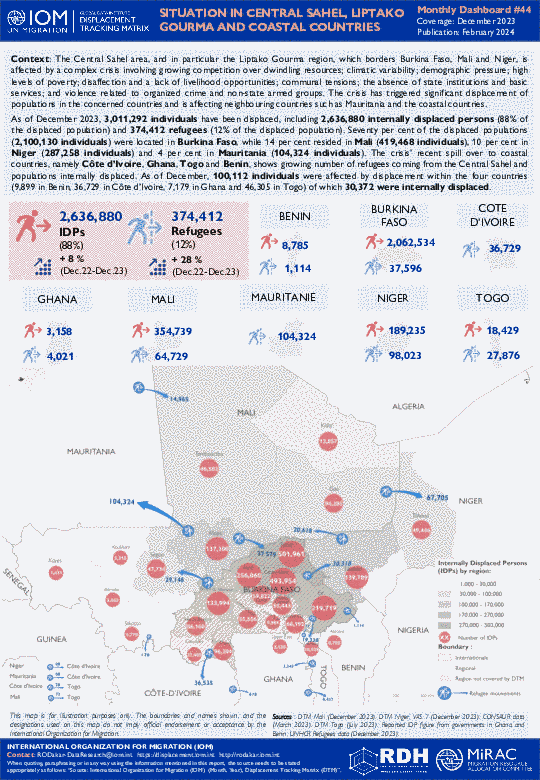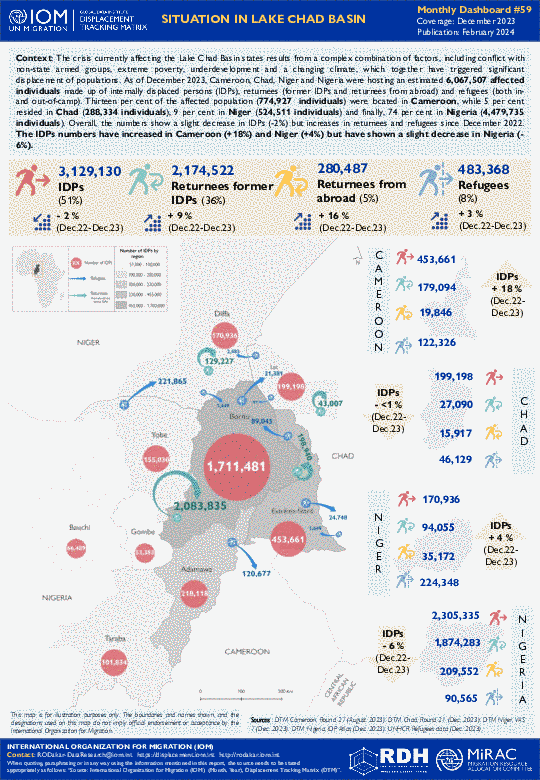-
Countries
-
Data and Analysis
-
Special Focus
-
Crisis Responses

Contact
DTM Europe, DTMMediterranean@iom.int
Language
English
Location
Serbia
Period Covered
Dec 15 2023
Dec 29 2023
Activity
- Survey
- Flow Monitoring
This report provides insights into the profiles, experiences and journeys of migrants transiting through the Republic of Serbia. Data was collected from 15 to 29 December 2023 together with the Commissariat for Refugees and Migrants of the Republic of Serbia (SCRM). Total of 112 migrants were interviewed in six centres (AC Banja Koviljaca, RC Pirot, AC Obrenovac, RC Bujanovac, AC Krnjaca, RC Presevo) across the country.

Contact
DTM Burundi, DTMBurundi@iom.int
Language
English
Location
Burundi
Period Covered
Jan 01 2018
Dec 31 2023
Activity
- Other
Since 2018, climate change and disasters, in particular torrential rains, floods and strong winds that occurred in Burundi affected 646,018 persons including 145,183 individuals that have been displaced. During this period, the main affected provinces were Bujumbura Rural (133,127 affected persons), Ngozi (113,686 affected persons) and Kirundo (107,377 affected persons). Alongside the severe human impact, these disasters destroyed many houses, infrastructures and crop fields in the country.
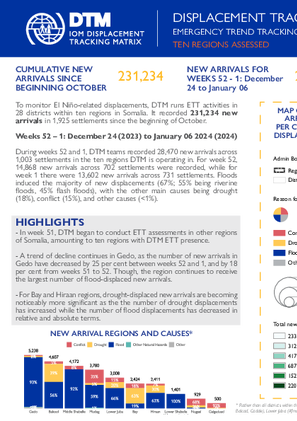
Contact
DTM Somalia, IOMSomaliaDTM@iom.int
Language
English
Location
Somalia
Period Covered
Dec 24 2023
Jan 06 2024
Activity
- Mobility Tracking
- Event Tracking
- Baseline Assessment
To monitor El Niño-related displacements, DTM Somalia runs ETT activities in 28 districts within ten regions in Somalia. ETT is a crisis-based tool that tracks sudden displacement triggered by specific events or emerging crises. The objective of ETT is to help prioritize humanitarian response and to enable partners to deliver rapid assistance.

Contact
DTM Europe, DTMMediterranean@iom.int
Language
English
Location
Hungary
Period Covered
Jan 01 2023
Dec 31 2023
Activity
- Survey
- Return Intention
- Flow Monitoring
The Crossing Back surveys conducted between January-December 2023 focused on individuals crossing back to Ukraine from or through Hungary, either for the short-term or long-term. For the purpose of the analysis, ‘’short-term visitors’’ are those who intended to spend 0-30 days in Ukraine, while respondents intending to stay for more than one month are labelled as “prospective returnees”.
The analysis of the survey participants’ marital status revealed a diverse range of relationship statuses. In total, over 61 per cent of the surveyed nationals identified as married, while 18 per cent of them reported to be single. Additionally, 12 per cent indicated being in a partnership, six per cent were widowed, and two per cent divorced. In 2023, the highest proportion of men were married (70%), followed by those who were single (17%) and those in partnerships (6%). Among women, a similar trend was recorded, as 59 per cent were married and 19 per cent were single. However, a higher proportion (13%) reported to be in partnerships, surpassing the equivalent figure for men.
Among the 1,253 survey participants, 76 per cent (N=948) were Ukrainian nationals, and 24 per cent (N=305) were Third-Country nationals (TCNs) with residence in Ukraine. The present analysis is derived from the responses of the Ukrainian participants.
Contact
DTMUKRAINE@IOM.INT
Location
Ukraine
Activity
- Mobility Tracking
Period Covered
Dec 01 2023 -Dec 31 2023
During this round of data collection, IOM Ukraine's Data & Analytics Unit conducted assessments in 253 hromadas across 70 raions and 23 oblasts and Kyiv City. Assessed hromadas were selected based on their relevance to humanitarian and recovery programming, pre-war population size, and known displacement trends, with a specific focus on areas closer to the frontline.
This is a restricted dataset. To get access, kindly click on the 'Request Access' button.
Population Groups
IDPs
Residents
Returnee (Previously Internally Displaced)
Survey Methodology
Unit of Analysis Or Observation
Admin Area 2
Admin Area 3
Site or Location
Type of Survey or Assessment
Key Informant
Keywords
Geographical Scope Partial Coverage
Administrative boundaries with available data
The current dataset covers the following administrative boundaries
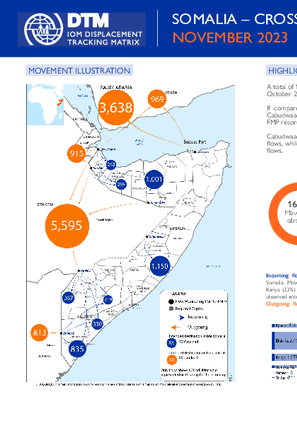
Contact
DTM Somalia, IOMSomaliaDTM@iom.int
Language
English
Location
Somalia
Period Covered
Nov 01 2023
Nov 30 2023
Activity
- Survey
- Flow Monitoring Survey
- Flow Monitoring
A total of 16,614 movements were observed in November 2023, representing a 37% decrease compared to October 2023 when 26,352 movements were observed during this period. If compared with October 2023, Doolow (-60%), Dhobley (-41%), Harirad (-26%), Bossaso (-4%), Cabudwaaq (-4%) and Lowyacado (-3%) FMPs recorded a decrease in movements while Buuhoodle (27%) FMP recorded an increase in movements. Cabudwaaq (25%), Dhobley (23%) and Doolow (17%) FMPs recorded the highest numbers of incoming flows, while Doolow (40%), Bossaso (39%) and Buuhoodle (7%) recorded the highest numbers of outgoing flows.
Contact
dtmlebanon@iom.int
Location
Lebanon
Activity
- Mobility Tracking
- Baseline Assessment
Period Covered
Oct 10 2023 -Jan 30 2024
Since October 8 there has been an increase in cross-border incidents between Israel and Lebanon, resulting in the displacement of people both within the South and elsewhere within the country. Since October 10, the Displacement Tracking Matrix (DTM) has been conducting the daily monitoring of population movements. The objective of the exercise is to inform preparedness and response planning.
Population Groups
IDPs
Survey Methodology
Unit of Analysis Or Observation
Admin Area 2
Admin Area 3
Type of Survey or Assessment
Key Informant
Keywords
Geographical Scope Full Coverage
Administrative boundaries with available data
The current dataset covers the following administrative boundaries
The Central Sahel area, and in particular the Liptako Gourma region, which borders Burkina Faso, Mali and Niger, is affected by a complex crisis involving growing competition over dwindling resources; climatic variability; demographic pressure; high levels of poverty; disaffection and a lack of livelihood opportunities; communal tensions; the absence of state institutions and basic services; and violence related to organized crime and non-state armed groups. The crisis has triggered significant displacement of populations in the concerned countries and is affecting neighbouring countries such as Mauritania and the coastal countries.
As of December 2023, 3,011,292 individuals have been displaced, including 2,636,880 internally displaced persons (88% of the displaced population) and 374,412 refugees (12% of the displaced population). Seventy per cent of the displaced populations (2,100,130 individuals) were located in Burkina Faso, while 14 per cent resided in Mali (419,468 individuals), 10 per cent in Niger (287,258 individuals) and 4 per cent in Mauritania (104,324 individuals). The crisis’ recent spill over to coastal countries, namely Côte d’Ivoire, Ghana, Togo and Benin, shows growing number of refugees coming from the Central Sahel and populations internally displaced. As of December, 100,112 individuals were affected by displacement within the four countries (9,899 in Benin, 36,729 in Côte d’Ivoire, 7,179 in Ghana and 46,305 in Togo) of which 30,372 were internally displaced.
The crisis currently affecting the Lake Chad Basin states results from a complex combination of factors, including conflict with non-state armed groups, extreme poverty, underdevelopment and a changing climate, which together have triggered significant displacement of populations.
As of December 2023, Cameroon, Chad, Niger and Nigeria were hosting an estimated 6,067,507 affected individuals made up of internally displaced persons (IDPs), returnees (former IDPs and returnees from abroad) and refugees (both in- and out-of-camp). Thirteen per cent of the affected population (774,927 individuals) were located in Cameroon, while 5 per cent resided in Chad (288,334 individuals), 9 per cent in Niger (524,511 individuals) and finally, 74 per cent in Nigeria (4,479,735 individuals). Overall, the numbers show a slight decrease in IDPs (-2%) but increases in returnees and refugees since December 2022. The IDPs numbers have increased in Cameroon (+18%) and Niger (+4%) but have shown a slight decrease in Nigeria (-6%).
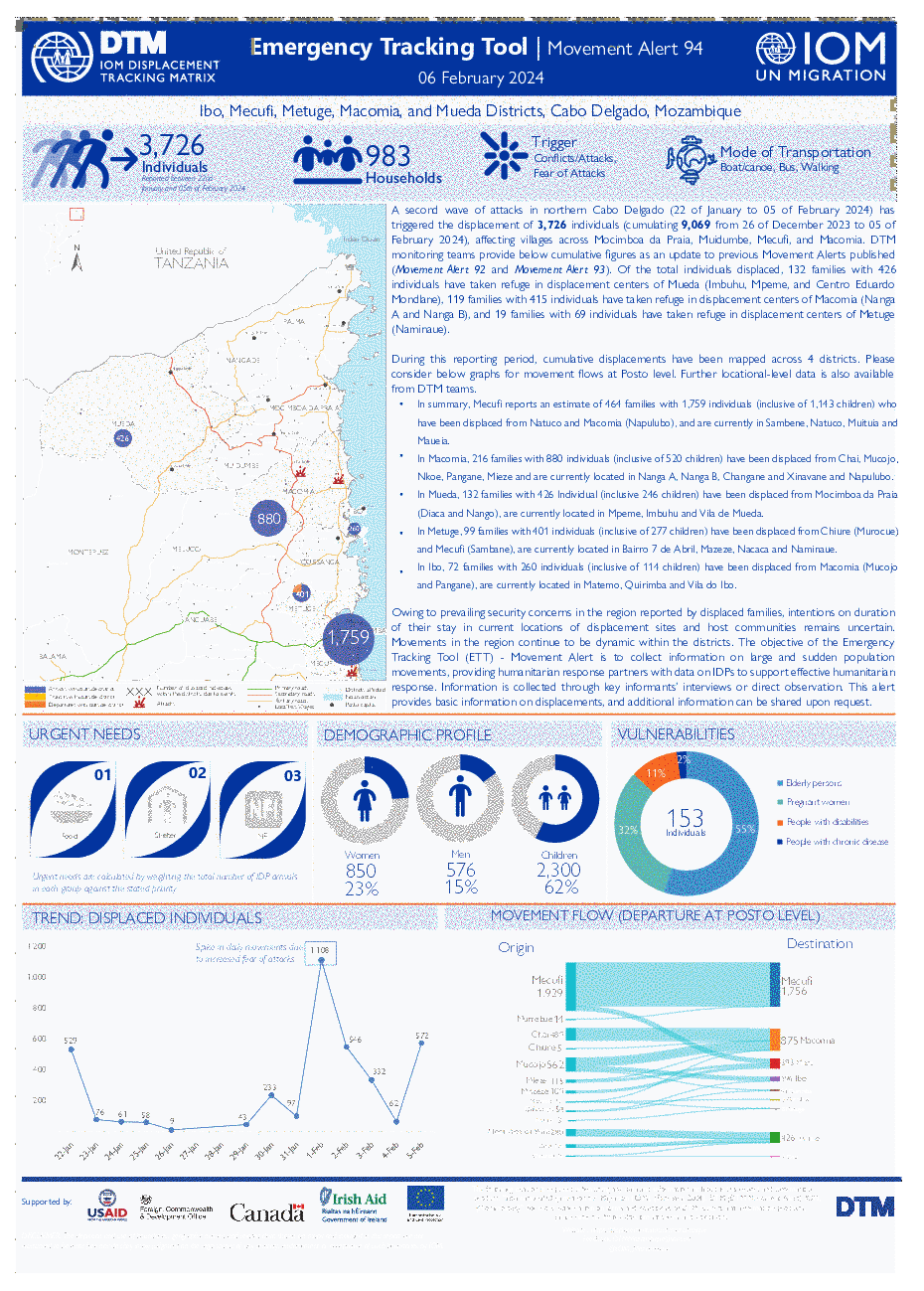
Contact
DTMMozambique@iom.int
Language
English
Location
Mozambique
Period Covered
Jan 22 2024
Feb 05 2024
Activity
- Mobility Tracking
- Event Tracking
A second wave of attacks in northern Cabo Delgado (22 of January to 05 of February 2024) has triggered the displacement of 3,726 individuals (cumulating 9,069 from 26 of December 2023 to 05 of February 2024), affecting villages across Mocimboa da Praia, Muidumbe, Mecufi, and Macomia. DTM monitoring teams provide below cumulative figures as an update to previous Movement Alerts published (Movement Alert 92 and Movement Alert 93). Of the total individuals displaced, 132 families with 426 individuals have taken refuge in displacement centers of Mueda (Imbuhu, Mpeme, and Centro Eduardo Mondlane), 119 families with 415 individuals have taken refuge in displacement centers of Macomia (Nanga A and Nanga B), and 19 families with 69 individuals have taken refuge in displacement centers of Metuge (Naminaue).
